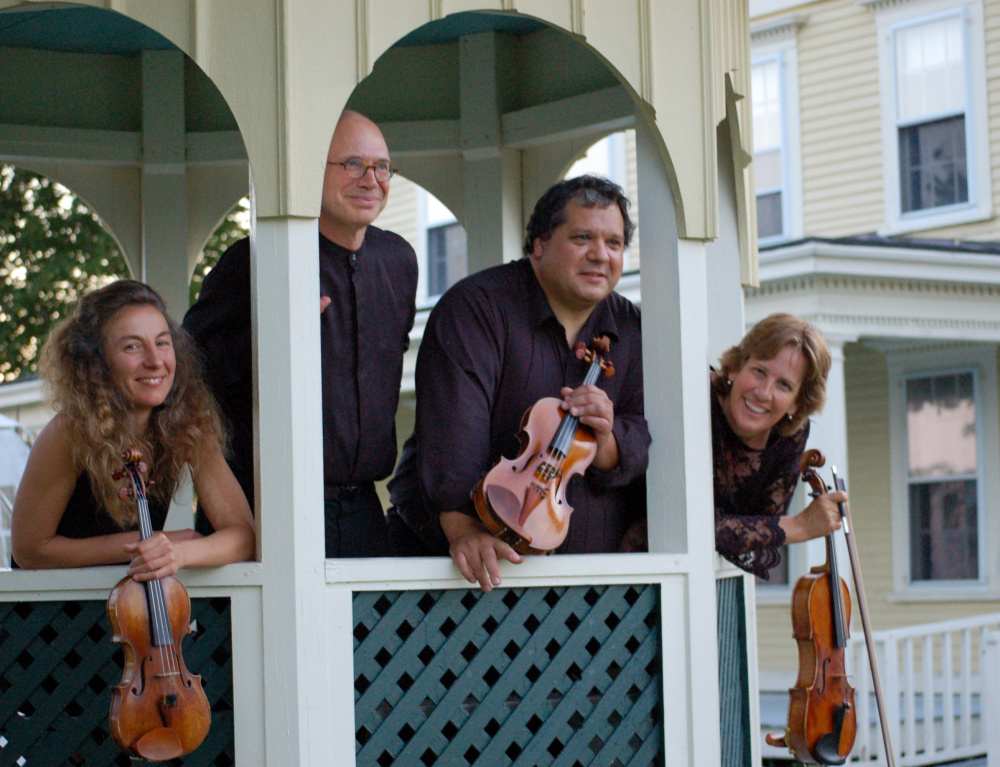The DaPonte String Quartet opened its new series on Nov. 5 at the Maine Jewish Museum with “Enemies of the State,” a provocative thematic program that brought together works by Erwin Schulhoff, Dmitri Shostakovich, and Wolfgang Amadeus Mozart.
Why provocative? Mozart’s presence under the concert’s title must have raised more than a few eyebrows.
Shostakovich’s inclusion is no mystery. His Fourth Symphony and his opera, “Lady Macbeth of the Mtsensk District,” were denounced by Stalin, and given the dictator’s penchant for eliminating people he disliked, including artists, Shostakovich spent much of his life in fear.
Schulhoff’s place on the list is self-evident as well. A prolific Czech composer, pianist and critic who built a promising career in the decades preceding World War II, he thrived in the wrong place and the wrong ways at the wrong time: Jewish and a Socialist, he built an omnivorous style that embraced everything from Dadaism to dissonant harmonies and jazz, all of which made him a target of the Nazis, who sent him to the Wülzburg concentration camp, where he died of tuberculosis in 1942.
But Mozart? He had a tense relationship with his early employer, Count Hieronymus Colloredo, the archbishop of Salzburg, but he eventually moved to Vienna, where he was appointed to a part-time position as chamber composer by Emperor Joseph II, but could otherwise compose what, and for whom, he liked.
In a fascinating introduction to a performance of the Quartet in A major (K. 464), however, Myles Jordan, the ensemble’s cellist proposed that Mozart, an active Freemason, may also have been a Masonic courier who carried messages between Vienna and Paris around the time of the French revolution. According to this theory, the Emperor had Mozart poisoned as a dangerous subversive.
This explanation of Mozart’s mysterious early death has not been widely accepted by scholars, but it’s a terrific yarn, and it explains Mozart’s inclusion here. More to the point, Jordan and his colleagues – Lydia Forbes and Ferdinand Liva, violinists, and Kirsten Monke, violist, gave the quartet a thoughtful, rich-hued performance to close the program. It can be hard, at more than two centuries’ distance, to hear the work as more revolutionary than courtly. It has a graceful Menuetto and Trio, after all. But the quartet’s flexible tempos and the sheer intensity it brought to the Allegro vivace finale, magnified the music’s human warmth and passion. This was not deferential, alabaster Mozart, but a vivid demonstration of Mozart’s heightened expressivity within seemingly courtly forms.
The DaPonte players opened their program with Schulhoff’s String Quartet No. 1, a 1924 work that puts the composer’s imaginative waywardness on display. Cast as three fast movements and a slow finale, it begins with a burst of harshness that melts quickly into a dance that has the character of a hoe-down – not what you expect of a Czech composer trained in Austria and Germany, but the unexpected was Schulhoff’s currency. So was the dark humor of the second and third movements, which parody formal dances, and are fitted out with tonal effects, including the eerily glassine whine of artificial harmonics.
The ensemble brought an incandescent energy to these first three movements, setting the stage perfectly for the dense, melancholy finale. Suggesting that this closing Andante molto sostenuto may be Schulhoff’s premonition of his sad ending, as Jordan did in his engaging introductory comments, is probably going too far: Schulhoff’s death was 18 years in the future. But the quartet played the movement as if it were the composer’s personal memorial, with a conviction that made the interpretation seem plausible.
That said, Shostakovich composed his Quartet No. 8 in C minor (Op. 110) in 1960, 15 years before his death, with seven quartets still to come, but he certainly did think of it as a memorial, of sorts. Its themes include a four-note signature – D, E flat, C, B (or DSCH, using European note-naming conventions) – as well as quotations from his earlier works, and it is rich in effects like the brusque repeated chords that evoke the police pounding on his door. Jordan said that the group had avoided this quartet because everyone else plays it. Given the searing energy and clarity the players brought to this score, it ought to be a centerpiece of their repertory.
Allan Kozinn is a former music critic and culture writer for The New York Times who lives in Portland. He can be contacted at:
allankozinn@gmail.com
Twitter: kozinn
Copy the Story LinkSend questions/comments to the editors.



Success. Please wait for the page to reload. If the page does not reload within 5 seconds, please refresh the page.
Enter your email and password to access comments.
Hi, to comment on stories you must . This profile is in addition to your subscription and website login.
Already have a commenting profile? .
Invalid username/password.
Please check your email to confirm and complete your registration.
Only subscribers are eligible to post comments. Please subscribe or login first for digital access. Here’s why.
Use the form below to reset your password. When you've submitted your account email, we will send an email with a reset code.